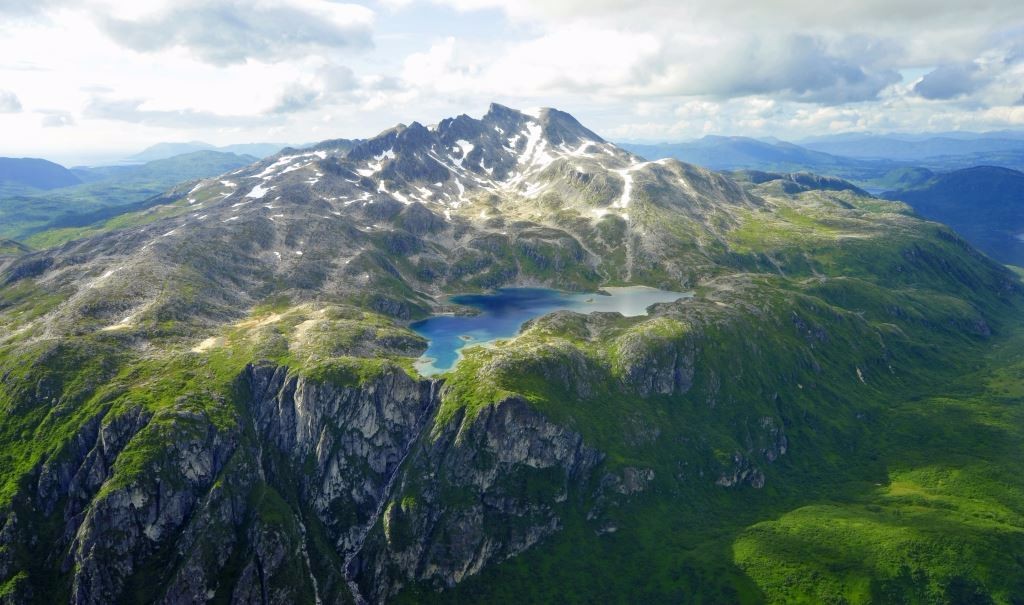Text and photos by Steve D’Antonio
Copyright © 2016
From the Masthead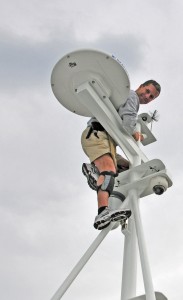
When you read this I’ll be aboard MIGRATION, a Nordhavn 68, cruising among the islands of Norway’s Svalbard Archipelago. The northern most portion of the island group is located at 81° north latitude, less than 600 miles from the North Pole. The world’s northernmost continuously inhabited region, Svalbard is known for its breathtaking scenery, including glaciers, fjords and snow-capped peaks, as well as its wildlife, reindeer, arctic fox, whales and other marine mammals, seabirds and especially polar bears (they have gun control here, of sorts, those going ashore are required to carry a fire arm). During mid-summer, the sun never sets. I won’t deny it, I revel in cruising destinations of this sort, the wilder and less populated the better. However, spending time aboard cruising vessels, especially those I’ve helped build, in remote locations far from help, keeps me attuned to the design and reliability of critical systems. Thanks to an Iridium GO! Satellite e mail transceiver I’ll not only stay in touch with my office, I’ll also post periodic updates to my Facebook page https://www.facebook.com/stevedmarineconsulting/ detailing the passage, as well as eventually writing a full length article. Stay tuned.

Map courtesy Wikimedia
Last month I had an opportunity to visit another Scandinavian country, Sweden, the home of Volvo Penta. As a guest of that company I was afforded the opportunity to sea trial several of their latest products at their Gothenburg waterfront facility, including the intriguing joystick maneuvering system designed for conventional shaft-drive vessels. On the following day I visited Volvo’s Vara engine manufacturing facility, where their venerable D4 and D6 engines are produced exclusively. The plant is the smallest production diesel engine factory in the world; a model of Scandinavian efficiency it’s also one of the few that’s carbon neutral. The visit was intriguing on many levels, both technically and culturally. I’ll write a feature article on this visit for an upcoming issue of Professional BoatBuilder magazine.
This month’s Marine Systems Excellence feature, the second of a two part series, picks up on Kodiak Island with grizzly bears, spawning salmon, whales, bald eagles and more. I hope you find it both enjoyable and inspiring.
Alaskan Excursion Part II
Last month I began to share with readers the story of a passage I made along the Alaskan coast last summer. In this second and final installment we’ll continue to explore Kodiak Island by sea and air, watch grizzly bears hunt salmon and cross the Gulf of Alaska.
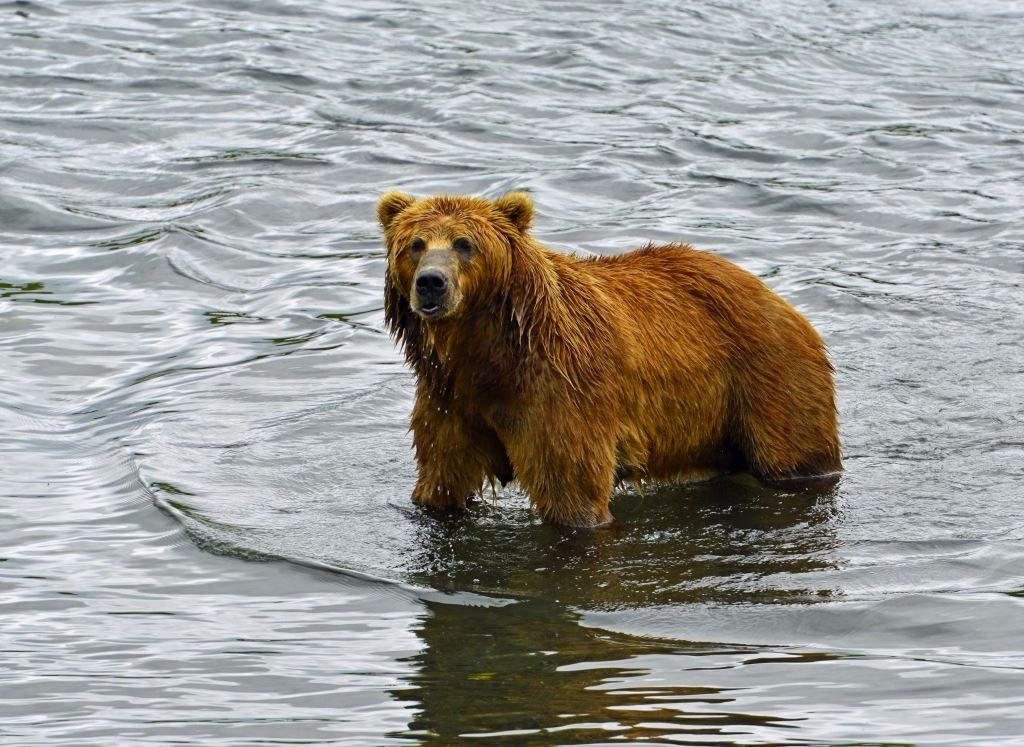
A grizzly bear stalks salmon in one of Kodiak Island’s many lakes.
After leaving Lazy Bay we continue on toward Olga Bay, a large inland body of water connected to the ocean via a narrow channel. By early afternoon we drop anchor for a few hours in aptly-named Anchor Cove, on the northwest side of the Bay. While we pass a few fish camps and an abandoned cannery on our circuit of the Bay, Anchor Cove is completely isolated, there are no signs of habitation, and our only neighbors are a couple of herds of harbor seals. Rain showers come and go. Game trails crisscross the luminescent green hillsides, many of which are obscured by low hanging clouds. With some time to kill before returning through Olga Narrows at slack tide, we launch the tender and explore the cove. Sea lions are abundant and surprisingly not at all shy, as are a trio of gull fledglings, who paddle about a small island, intermingling with the seals. Along the shore a lone river otter looks at us briefly and then scurries off into the brush.
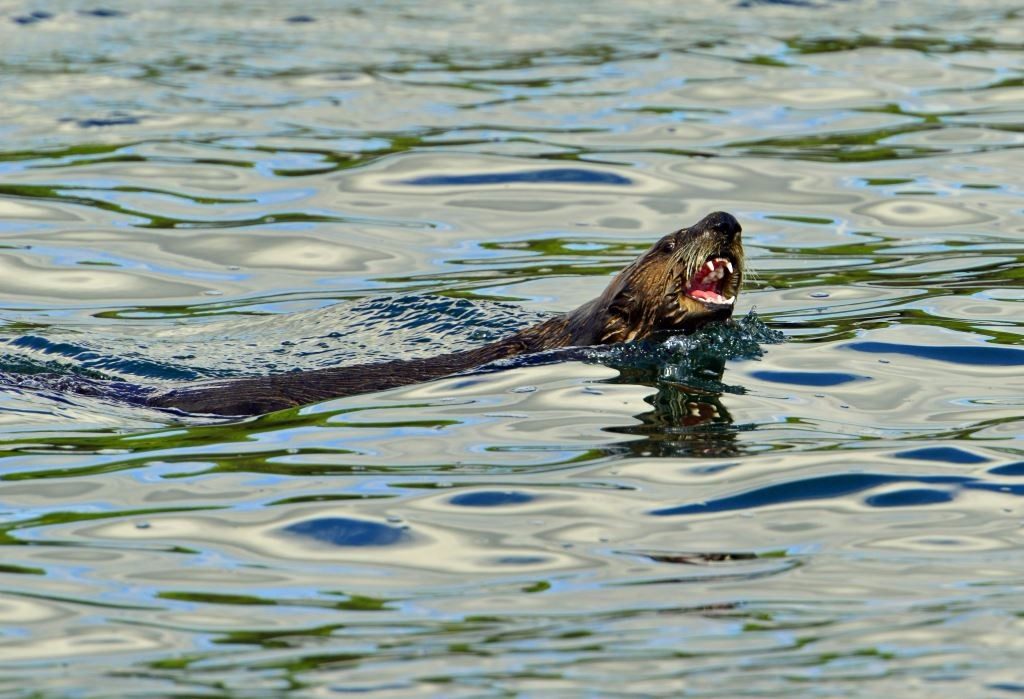
After dropping anchor this otter swam around Venture for hours crying out a mournful dirge, clearly we’d invaded his territory.
We weigh anchor and head back to the Narrows to catch the tide, exploring the shoreline as we go, including an area called ‘Horse Marine Lagoon, Stream and Lake’. The shore is dotted with homes and sheds of set net fishermen, a few of whom we encounter in a small open boat, and the hills here, like all those I’ve seen in this area, appear to be a thick carpet of velvet-like grass and brush, stretched out over the rocky surface. The outfall from this lagoon is filled with jumping salmon. We drop anchor in Chip Cove, adjacent to one of the ubiquitous abandoned canneries.
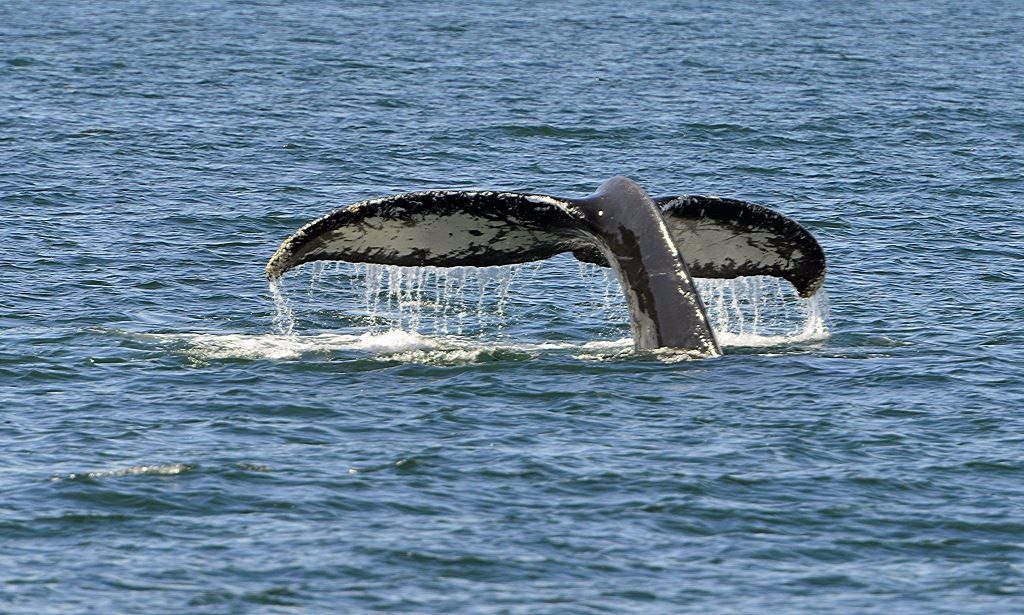
A humpback whale sounds after “bubble netting” a meal.
We awaken the following morning to the hum of steady rainfall, which squelches our plans to go ashore and explore. We decide to get underway to make a 100 mile day. However, when retrieving our anchor our windlass fails, mercifully with only about ten feet of chain remaining out. I troubleshoot it, in the frigid driving rain, only to find that one power stud on the motor has overheated and is completely parted from the winding. It’s not repairable, at least not here. With that, we reluctantly head for Kodiak, 120 miles away, cutting short our trip and bypassing some of the places we had intended to visit. This detour also gives us an opportunity to also replace a leaking hydraulic hose.
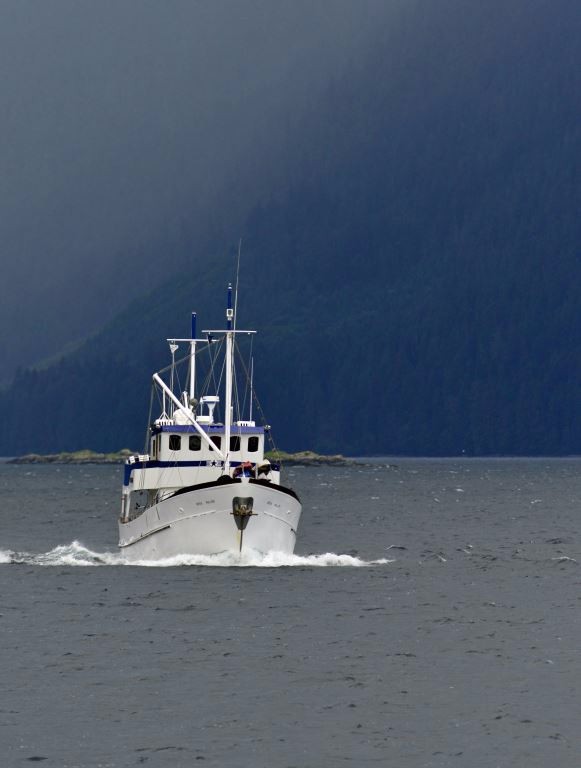
With rain-enveloped Admiralty Island as a backdrop, the charter vessel Ursa Major makes her way south.
On our abbreviated route we pass Sitkalidak Island, it is here that the massive Shell oil drilling platform Kulluk was cut loose from its beleaguered tow boat in the midst of a winter storm, where it fetched up on New Year’s eve 2012, between Ocean Bay and Partition Cove, a shoreline we cruise close by and scrutinize, imagining what that scenario must have been like for the rig’s and tug’s crews. Kodiak has seen other such disasters; including the infamous oil spilled from the Exxon Valdez, which enveloped this island, the slick ultimately covering over 1000 square miles of Alaska’s pristine coastline. We pass locations on the chart with names like ‘Dangerous Cape’, ‘Boulder Bay’ and ‘Humpback Rock’. Seabirds are in abundance in this area, the steep cliff faces providing ideal nesting grounds, within a few minutes I spot and identify fulmars and murres of several varieties, puffins, two black footed albatrosses, northern, short tailed and sooty shearwaters and a red-footed pigeon guillemot.
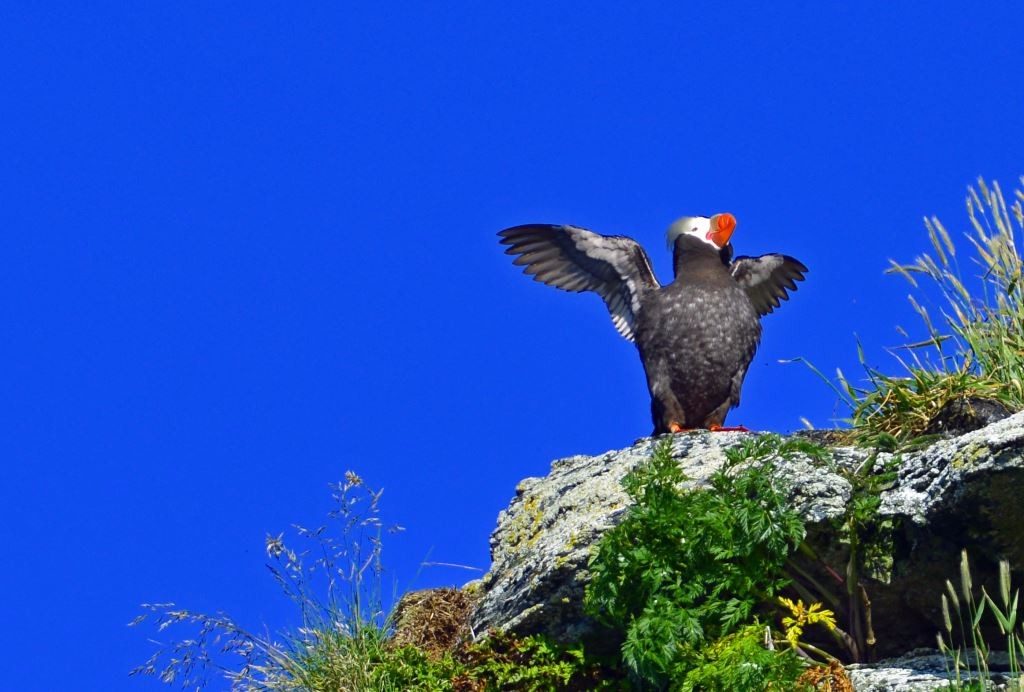
A puffin spreads his wings while perching on a pinnacle rock near Saposa Bay.
Over the course of three days, two local repair shops in Kodiak attempt to repair the motor without success, ultimately forcing us to have a replacement flown in from Sydney, British Columbia. The wait is interminable, we are stuck dockside, with agonizingly beautiful weather, for nearly a week. On the other hand, the hydraulic repair goes much better; this being “hydraulic country”, a waterfront shop literally makes a new hose in five minutes.
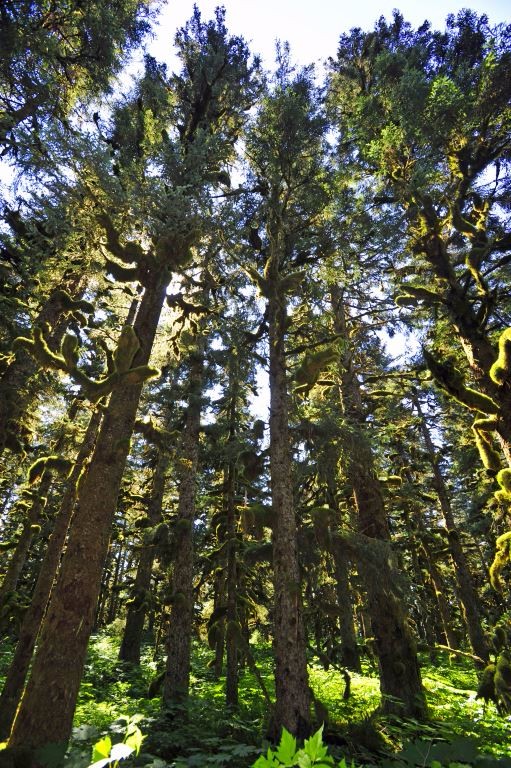
A enticing as Alaska’s seascapes may be, her forests are equally as enchanting.
Back in 1965 Kodiak and much of Alaska’s coastline was inundated by a tsunami following an earthquake. In the town of Kodiak a small, inconspicuous stone block with a plaque marks the “high tide” line, adjacent to a gas station. It looks to be about 30 feet above sea level. The devastation here was significant, obliterating homes, businesses and most of the fishing fleet.
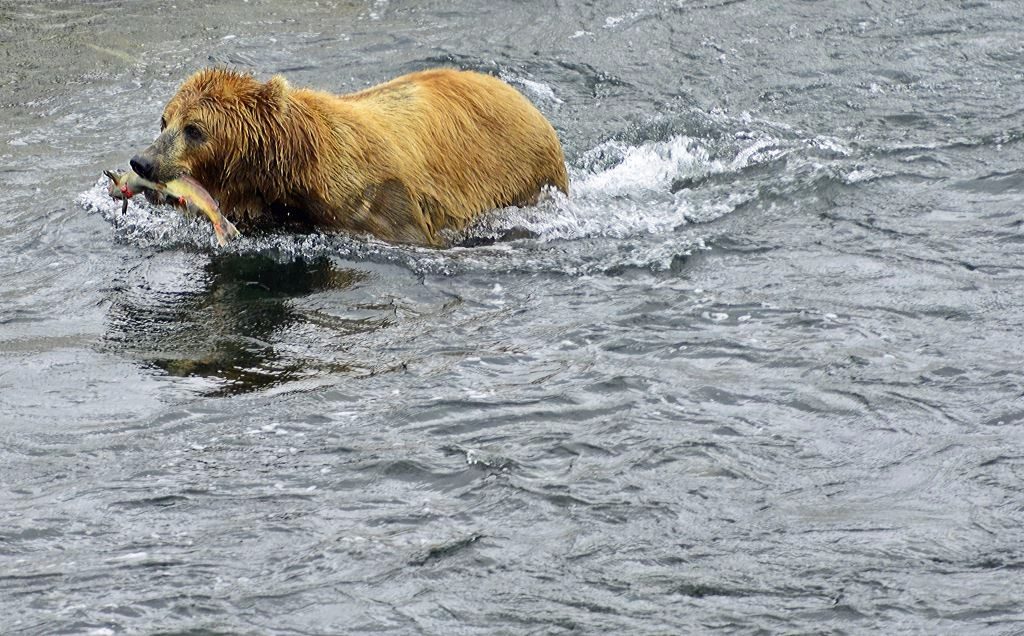
Fishing, grizzly bear-style.
During our delay we opt to put the time to good use by chartering a seaplane to take us to one of Kodiak’s innumerable lakes, in the hope of seeing some grizzly bears feeding on salmon. By early afternoon we are airborne and headed towards the island’s far southern end, overflying the Alitak cannery we visited previously, and retracing some of the route we took by sea a few days ago. The weather is clear with blue sky and full white clouds, the breathtakingly beautiful scenery glides by at a leisurely 110 knots, turquoise high mountain lakes, glaciers and snowcapped peaks, streams and bays, the latter punctuated by the occasional fishing boat, and again countless game trails. From our altitude, which rarely exceeds 500 feet above ground level, we can see schools of salmon at the mouths of rivers and streams, as well as deer, bears and mountain goats, some of which we pass at eye level. We fly above a pair of eagles in flight, and then encounter a female bear and two cubs feasting on a beached whale carcass. Kodiak has so many streams they don’t bother to name them, they are simply numbered. Volcanos, earthquakes and tsunamis are a way of life here and if you look for it you can see the evidence (I see the distinctive buff-colored ash pits from volcanic eruptions during the flight), and swaths of dead trees that have been inundated by the waves.
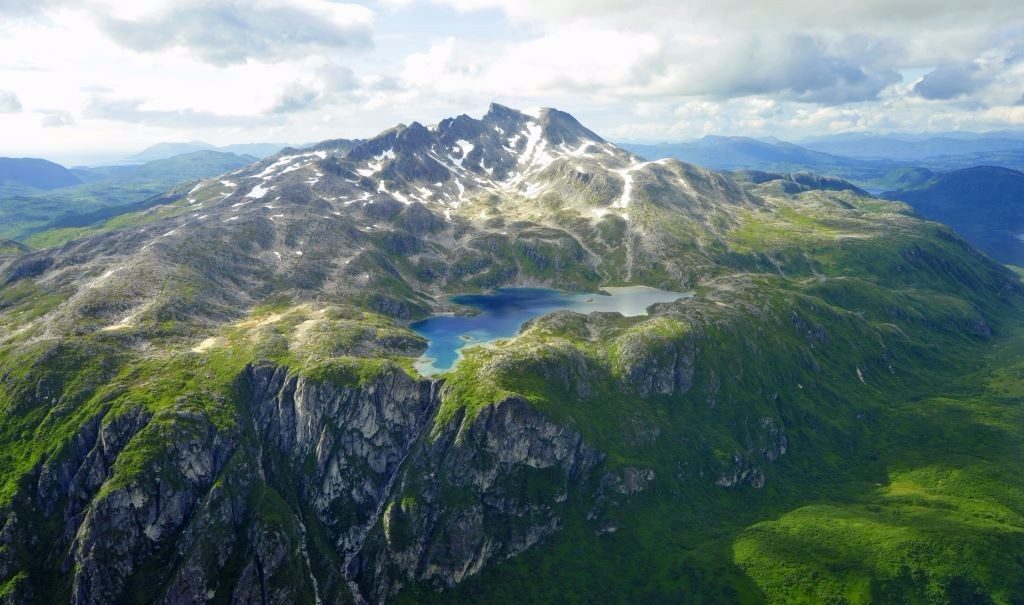
One of Kodiak Island’s high mountain lakes. Buff colored ash deposits attest to the region’s volcanic activity.
After nearly an hour’s flight, we touch down on Frazer Lake. We hike nearly a mile until we come to a waterfall and fish weir, at the bottom of which we can see seven bears, two mothers each with two cubs, and one very large male. The cubs patiently watch the adults hunt for fish, as they nibble on green grass and leaves, occasionally wrestling with each other. The adults rush to and fro making great splashes, occasionally poking their heads underwater and marching like an inverse periscope to look for fish. Our viewing position is at times no more than fifty feet from the bears, and while our pilot carries a firearm, he says he’s never needed to use it. The lone male at one point begins to stalk one of the females with cubs, she immediately senses this, and leaves the water hastily, trotting up a hillside with cubs in tow, stopping every once in a while standing up on hind legs to look back for her pursuer. Males are known to kill cubs. For the most part, however, other than an occasional glance, the bears ignore us.
Sidebar: Directly north of Kodiak Island, on the Alaska Peninsula, lies Katmai National Park, a coastline we’ve cruised along for days now, which encompasses a volcano called Novarupta (Russian for New Eruption, once again emphasizing the strong Russian influence in the area), and the adjacent Valley of Ten Thousand Smokes. In 1912 this volcano erupted with a magnitude that was unprecedented, it was the largest eruption of the 20th century, many times that of Mt. St. Helens. Because the region was and remains sparsely populated, there were no recorded deaths, however, the descriptions of the fall out in nearby areas, abound. Kodiak was buried in feet of ash, one account notes that at times the ash fall was so heavy a lantern held at arm’s length could not be seen.
Upon our return we are greeted by a replacement windlass motor, which is quickly installed and tested. We cast off our lines early the next morning, fuel up and are underway. After two more stops on Kodiak, we set out across the Gulf of Alaska for Sitka. Two and a half days later, at 9:00 AM 3,200 foot Mount Edgecumbe, an extinct volcano on Kruzof Island, comes into view, and after 55 hours and 560 nm Venture drops anchor in Sukoi Bay, in SE Alaska. We have lunch and then enjoy some much needed rest.
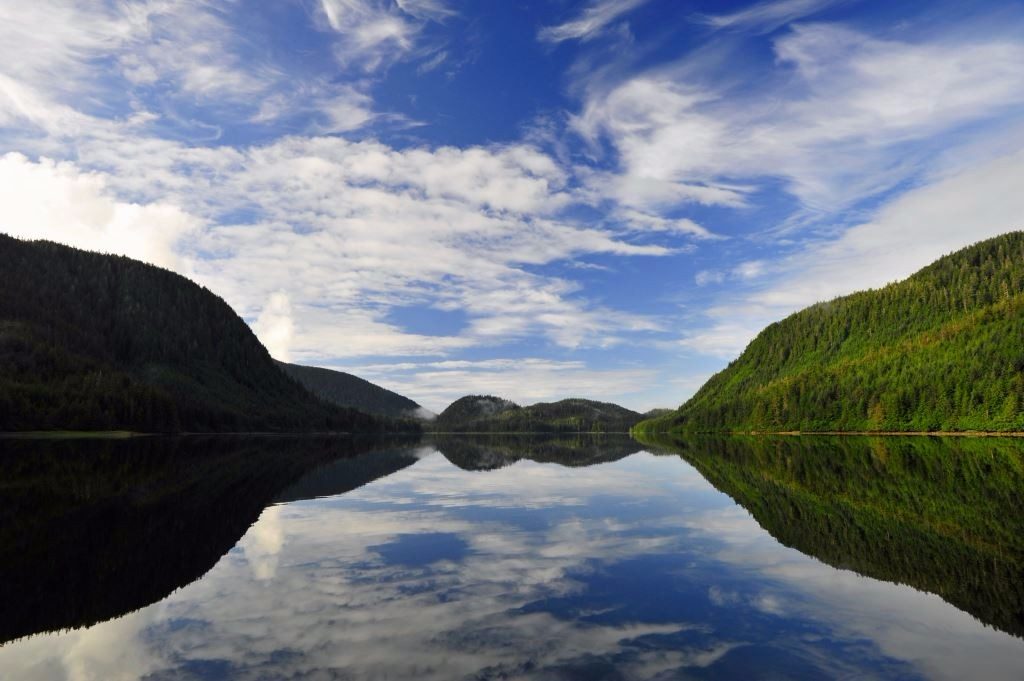
In Sukoi Bay a mirror-like arm and blue sky make for a perfect picture.
As we catch up on chores we notice a mother bear and cub strolling along the shoreline, occasionally stopping to munch on grass. While I stand in the cockpit watching them I notice an eagle dive into the water, pouncing on a fish, an all too common sight, however, he apparently miscalculates, disappearing completely beneath the surface. He reappears and I watch him through my camera lens, he doesn’t seem to panic, he just rests there for a while, his white head and yellow beak clearly offset by the black water. Eventually he begins swimming to shore, using his wings to do a crude breast stroke, roughly 100 yards away. He slowly clambers up onto the beach and perches on a half-submerged branch, looking bedraggled but otherwise no worse for the wear, the fish appears to have made good his escape. His mate flies cover, calling the whole time, as if to say, “I can’t believe you did that!” After dinner the mother bear and cub return to the beach, the mother fishes for salmon unsuccessfully while the yearling runs about playing. The mother eventually gives up and walks dejectedly back toward the forest. The two eagles from the day’s earlier performance are perched in a tree directly above the bears, however, they are about thirty feet apart, and they look as if they are not speaking to each other.
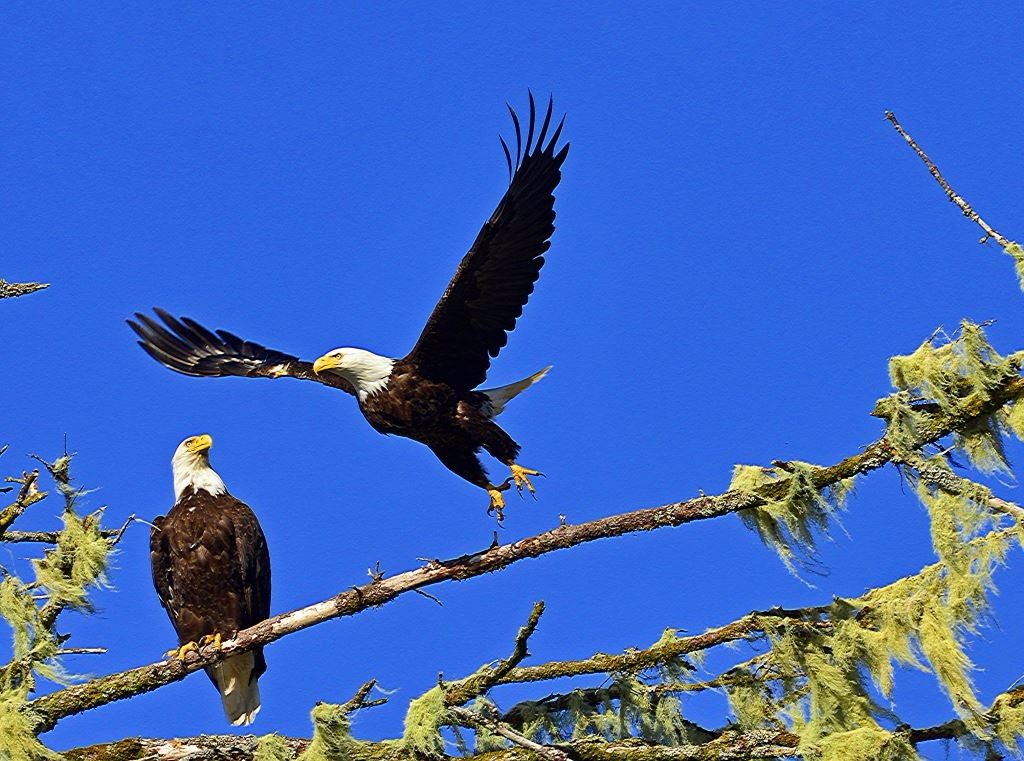
Regardless of how often they are encountered, it’s difficult not to be awed by bald eagles.
Venture works her way along the coast, headed for Sitka and my rendezvous with Piredmus, a Nordhavn 63 I’ll board and cruise with for a few days. One of our final excursions is to Saint Lazaria Island. A wildlife refuge, the small uninhabited volcanic plug is now home to thousands of nesting birds of a wide variety, 250,000 breeding pairs of storm petrels, 4000 murres, 2000 breeding pairs of puffins, and 1,000 breeding pairs of rhinoceros auklets, as well as black oyster catchers, peregrine falcons and bald eagles.
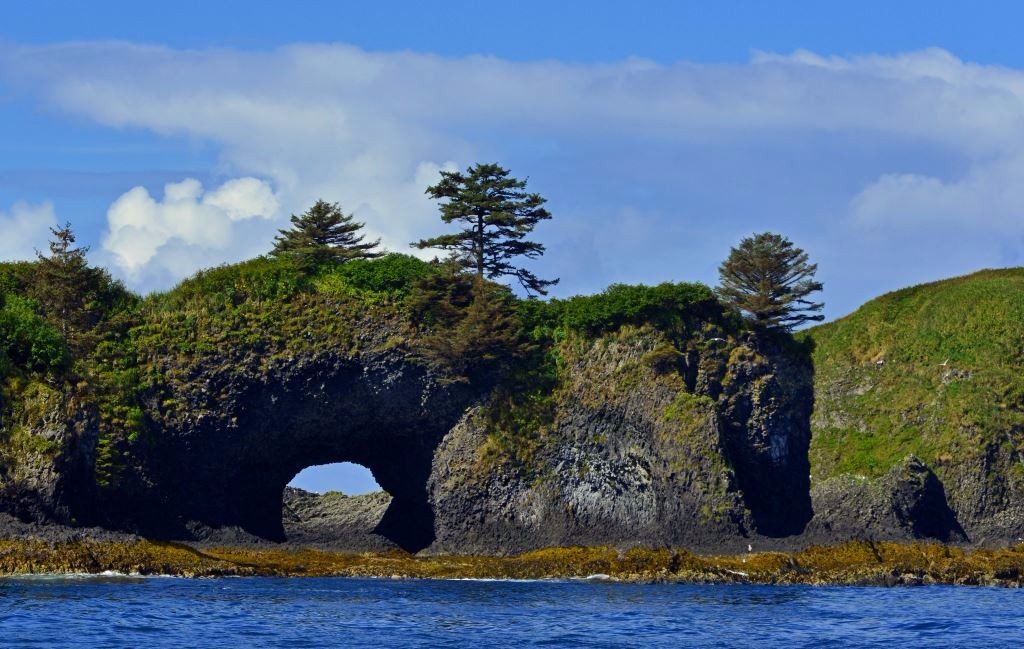
Home to thousands of nesting birds, enchanting and mysterious Saint Lazaria Island.
The island is exposed to the open Pacific Ocean, making the swell, even on the lee side, treacherous (guidebooks discourage landing and it’s easy to see why), while the windward side is reminiscent of the island from which Papillion made his final escape, rocky, jagged and razor sharp. The sea is comparatively calm during our visit, yet waves still crash on the lava rock shore in great bursts of white spume; creating a large swath of foam which stretches from the island’s northwest point like a jet’s contrail. The island’s steep cliffs, symmetrical tidal arch, from which an equally symmetrical evergreen grows, and a blow hole make it all the more picturesque. We loiter on the lee side, admiring the features and numerous birds, then circumnavigate, taking in the windward side’s sheer cliffs and bold headlands. The sky is azure, presenting the ideal backdrop, which includes Mount Edgecumbe in the distance. As we venture around the windward side we encounter a diagonal rock that looks as if it’s broken off the island and fallen into the sea, it’s the size of a large house, the base is wreathed in breaking waves and foam, and to the surface of which cling scores of silky black cormorants.
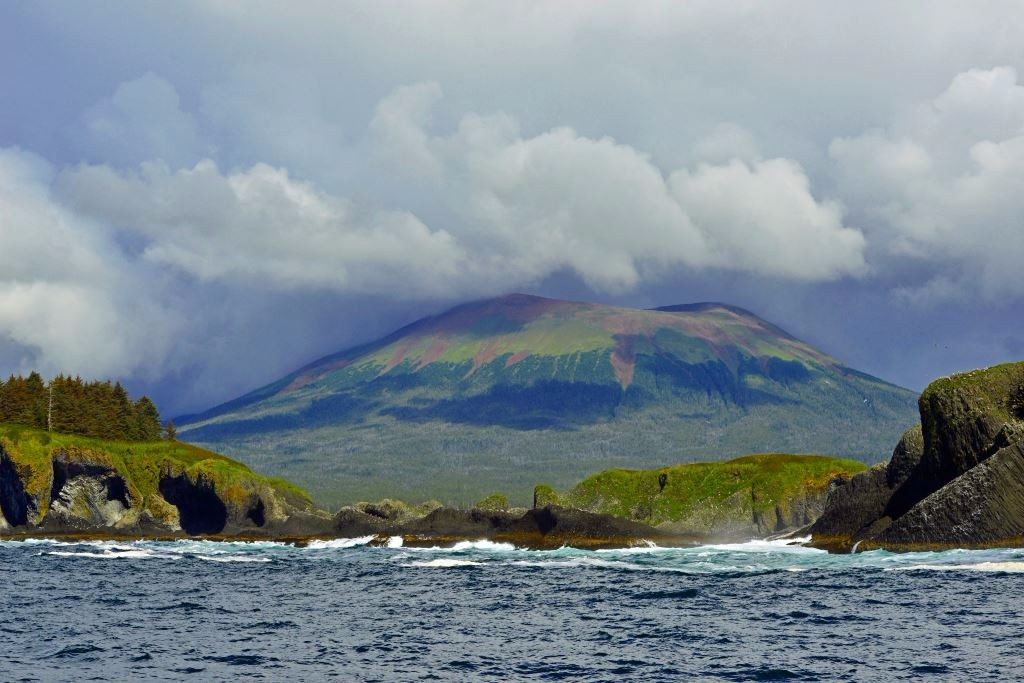
Looking very much like the extinct volcano it is, imposing Mount Edgecumbe wreathed by clouds.
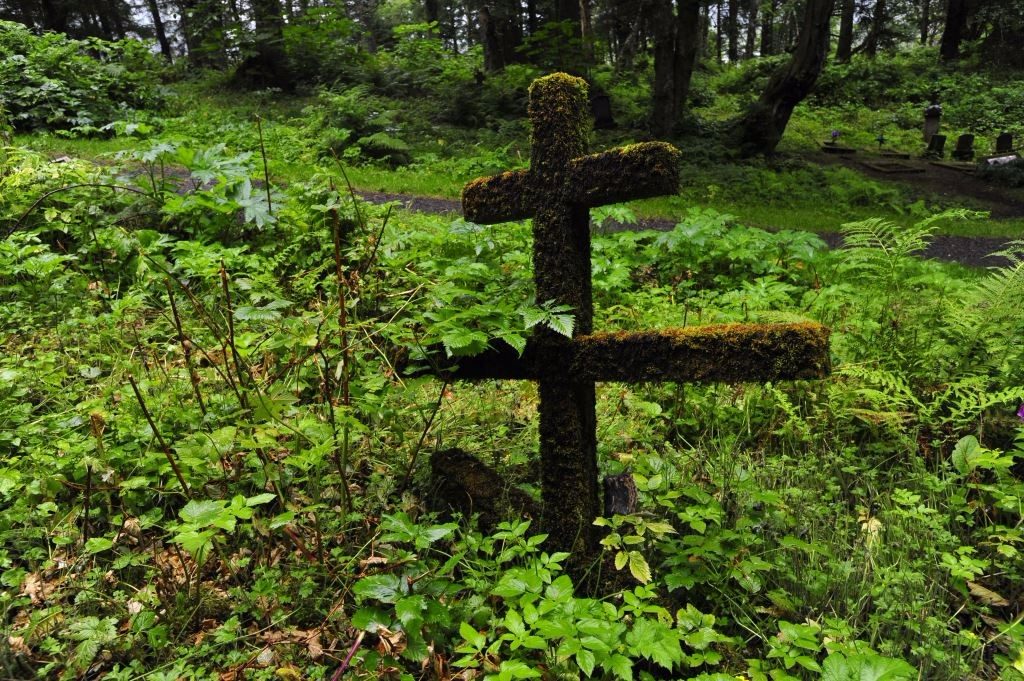
Russian Orthodox religious influence is strong throughout coastal Alaska. Here a moss-covered cross stands guard over a long-forgotten grave in Sitka.
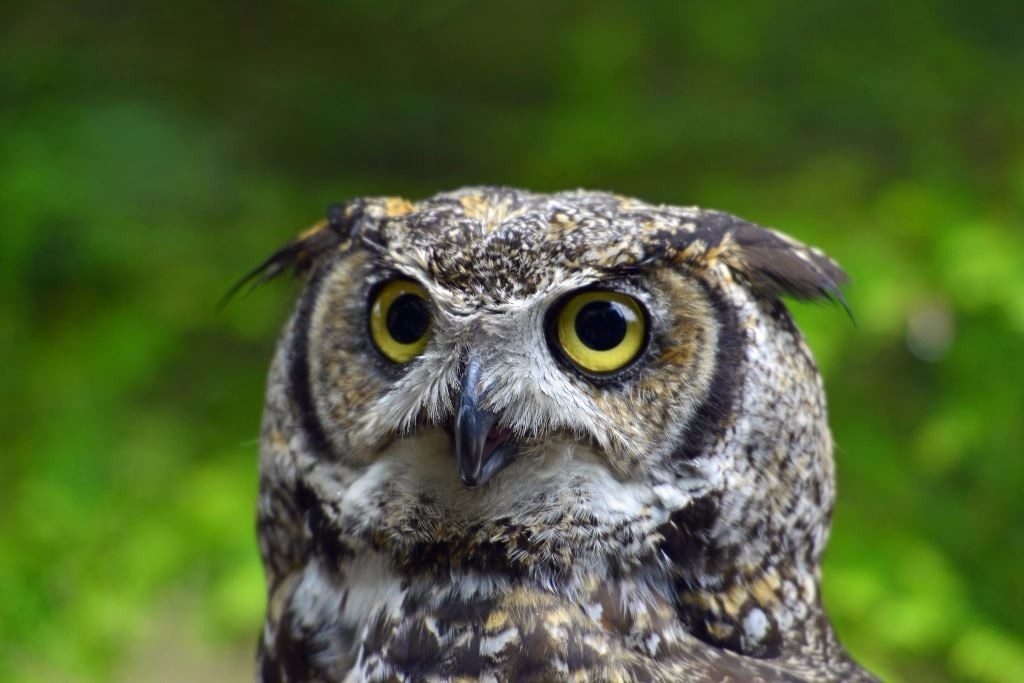

Long term residents of the Alaska Raptor Center in Sitka.
Sitka comes into view, signaling my final stop aboard Venture. After spending a day in this port, during which I visit the overgrown and hauntingly beautiful Russian grave yard, and the not to be missed Alaska Raptor Center, I bid farewell to Venture and move aboard Piredmus, my home for the final week of my Alaska excursion. Piredmus, owned by long-time clients and friends, and newly minted cruisers and retirees Tim and Michele, took delivery of their new vessel earlier in the year, sailing it up from Southern California to Southeast Alaska, as an ambitious but rewarding shakedown. I spend the next few days with them as we head to Petersburg, my final disembarkation point.
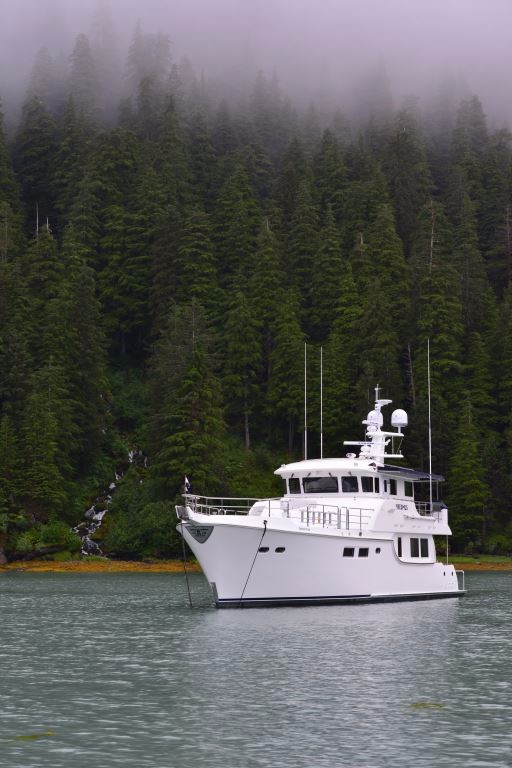
Piredmus, a Nordhavn 63, rests at anchor in secluded Takatz Bay.
Among the more memorable anchorages during my nearly 200 mile passage aboard Piredmus is Takatz Bay, on Baronof Island. The cove in which we anchor is the very epitome of protected, three sides are surrounded 3500 and 4500 foot mountains, wreathed in clouds. The water is an iridescent jade mist green; we anchor and our stern comes to rest not 50 yards from a blusterous waterfall.
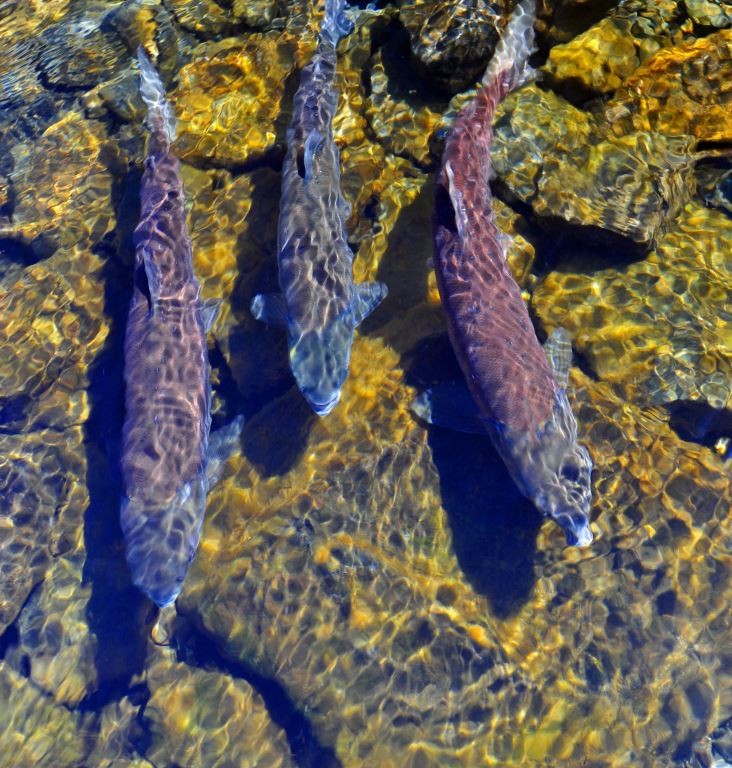
Salmon ‘treading water’, waiting to travel upstream to spawn.
After dinner we launch the tender to explore the area and head up toward the outfall of Takatz Creek, which flows into the head of the bay. The water is simply teaming with salmon; they are surfacing everywhere, surging toward the creek and up to the lake that feeds it, to spawn. The setting is idyllic, a fallen tree spans the stream a hundred yards from the falls, and because the tide is high we are able motor up to it, and hold our position while I take photos. While I’m fixated on the majesty of the rapids Tim spots a black bear at the edge of the stream devouring salmon, saying in a whisper, “Bear, there’s a bear, right there!” I turn and see him not 50 yards away, and raise my camera to capture the image.
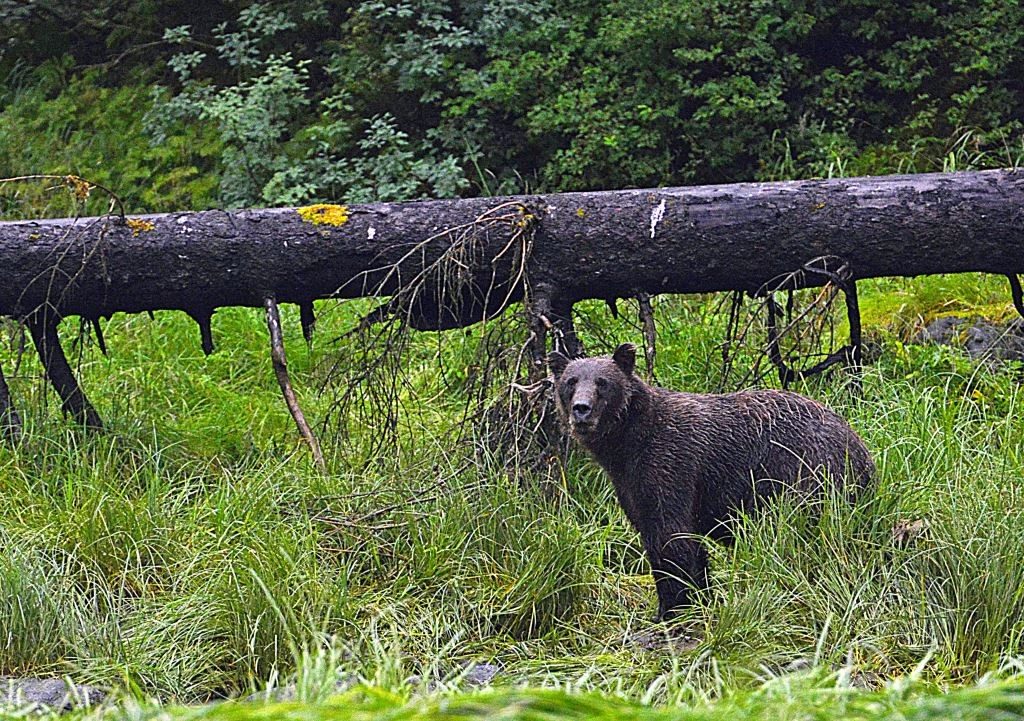
A black bear, with salmon scale mustache, glances out way before fading into the brush.
He is wary of us and after a minute begins to lumber off like a linebacker leaving the field; he stops on the far side of a fallen tree and stands on his hind legs to look at us for another minute, before melting into the heavy forest with a sole, hesitating, backward glance. On the way back to the Piredmus we pass a riot of eagles, perched in trees, and standing on the shingle beach at the water’s edge, they too have come to reap the harvest of spawning salmon.

